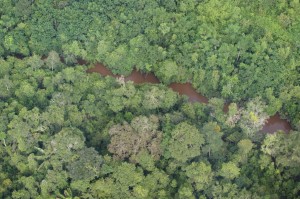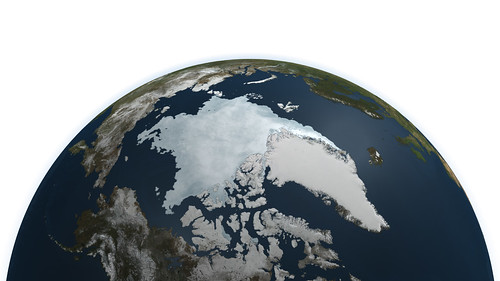Search Results for Tag: climate change
More intense hurricanes due to global warming
Many people in the world are following the way of hurricane Sandy at the moment, which hit U.S. Eastern coast last night and caused floodings and black outs in the New York area.
The densely populated and technologized regions at the Atlantic coast of the U.S. are at higher risk for more and more intense hurricanes in future time – also due to climate change, scientists say. There are mainly two criteria that account for this link: the increased ocean surface temperatures and regional cycles that amplify the effect.
Nontheless it is not that easy to link one particular weather event (as hurricane Sandy is) directly to climate change. Scientific evidence rather provides a model for the overall situation: the projections show that the criteria named above theoretically lead to more events like Sandy. But so far scientist cannot precisely forecast single weather events to come due to climate change.
New Directions for the Brazilian Amazon
The Amazon rainforest is spread out over nine national states of the South American continent. As trees bind carbon dioxide (CO2), the Amazon forest plays a crucial role in climate protection measures. Home to 60 percent of the world’s rainforest area, Brazil contains the largest part of this precious ecosystem.
GLOBAL IDEAS asked Brazilian forest activist Pedro Soares to write a guest article for our blog. Pedro stresses that we can only protect the Amazon by providing an adequate income to those living in the forest.
By Pedro Soares
The Brazilian Amazon area covers about 50 percent of Brazil’s territory. That is a total an area of 4,196,943 square kilometers.
The biggest stock of tropical forest in the world has always been seen as a barrier to regional economic development. In fact, deforestation occurs mainly due to an economic rationale: the forest does not provide sufficient income for landowners and forest dwellers, when compared to the income they could obtain for more profitable activities such as logging, agriculture or cattle ranching. But the lack of an economic value for the stand forest is the main caveat towards the promotion of forest conservation policies and programs.
![]() read more
read more
Landing on the moon was fake, so climate change is a lie

What do the moon landing and climate change have in common? They’re both fake. Well, at least if you belong to a certain small but very vocal group of people. As a part of this group, you might also be convinced that 9/11 was an inside job, that the CIA killed Martin Luther King and, yes, that radical free market policies will cure all the world’s ills.
Climate change deniers tend to be also conspiracy theorists and hard core free market ideologues, a new study finds. Apparently climate change denial very often goes together with the usual host of other fringe convictions and opinions. The reason for this, the climate science psychologist Adam Corner speculates in the Guardian could be
“…that it is the libertarian instinct to stick two fingers up at the mainstream – whatever the issue – that is important. Because a radical libertarian streak is the hallmark of free-market economics, and because free market views are popular on the political right, this is where climate change scepticism is most likely to be found.”
So what’s the solution? Corner suggests that
“the challenge of engaging with climate change sceptics is finding the lens that better fits their ideological views – not just shouting the science more loudly.”
Or maybe climate change has to be turned into a rogue topic – censored in the news, blasted by scientists, decried by the public – before it gains acceptance – among deniers. But then again, there is no such thing.
An island running dry

Photo: S. Ferse, ZMT
Climate change is looming large in the island state of Indonesia, where rising sea levels pose a major risk. But it’s actually a different problem that might force inhabitants of the Spermonde archipelago lying off Southern Sulawesi to leave their islands: drinking water is running low, and the existing water quality is getting worse.
A team of German and Indonesian scientists is pointing to climate change as a major source of that problem. Many of the islands get their drinking water from a freshwater lens – a layer of drained rainwater that accumulates in the soil. Just one lens is about ten to twenty centimeters deep and covers a large part of the archipelago.
Because of climate change, the island region is expected to be face more and more extreme weather patterns, from droughts to severe rain. But the torrents of water that hit the earth during monsoon seasons don’t have enough time to seep into the soil. Instead, the lion’s share flows over the earth’s surface and into the ocean. And the growing amount of sealed surfaces make matters worse: because the area is densely populated, a lot of ground is covered by streets and buildings. Plus, heavy storms – expected to become more frequent – are washing seawater onto the islands and into wells.
Still, climate change is just partly to blame for the dwindling water resources. Since the beginning of 20th century, not only the number of inhabitants but also the demand for drinking water has doubled. As there are no rules preventing anyone from digging wells anywhere and no official limit on how much water may be drawn from them, many locals have dug wells themselves. But they have little knowledge of the soil’s properties or the freshwater lenses when pumping. And when salty water from deep below mixes with the fresh water near the surface, it becomes increasingly brackish – bad for people and the environment.
Arctic defrosting faster than ever
With the world expecting to celebrate world records at the London Olympics from today, the weather in recent weeks has delivered many high scores we should be less happy with: Record breaking high temperatures in the USA, droughts in Canada or deadly floods in Russia are just the most prominent examples.
Now there’s more. This summer, ice in arctic regions has been melting more extensively than ever seen before.
NASA scientists reported that in mid-July a whopping 97 percent of Greenland’s ice surface was melting. While the amount of surface melting can change extensively and in a matter of days (depending on the temperature of the air above), it’s never been observed to cover that large an area in more than 30 years of satellite observations.
Is this just a freak event or global warming in action? Scientists are careful not to draw a direct link between extreme weather events and climate change. For good reason: Some phenomena may not have been observed before, but scientists are not surprised to see them regardless of a global warming. Cores drilled out the Greenland ice sheets can help recover the temperature history for the place and indicate that extreme melting regularly occured every 150 years or so. This summer’s thawing episode is “right on time”, says one NASA glaciologist.
But the accumulation of extreme weather events is something you would plausibly expect under conditions of global warming, says Global Ideas climate expert Anders Levermann of the Potsdam Institute of Climate Impact Research. Even then, “we can’t say what the further impacts will be,” he cautions. In the case of Greenland “we don’t know what a period of extreme melting actually means except that in this moment more water is being lost and the water level is rising.”
Taking a long hard look at individual regions, however, can help establish more direct links between regional trends and global warming. At least 70 percent of the reduction of Arctic sea ice over the last 30 years may be man made suggests a study by a British-Japanese team of scientists. Here’s how the lead author puts it:










Feedback